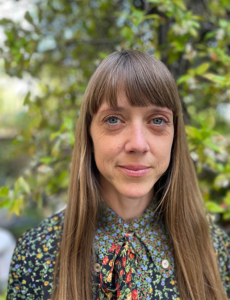 Welcome to this month’s Industry Insider guest, Taylor Norman, a rock star in the realm of children’s literature as Executive Editor at Neal Porter Books/Holiday House. Let’s give her a big, warm welcome!
Welcome to this month’s Industry Insider guest, Taylor Norman, a rock star in the realm of children’s literature as Executive Editor at Neal Porter Books/Holiday House. Let’s give her a big, warm welcome!
Taylor is the editorial force behind some of the most captivating and impactful picture books you’ll find on shelves today. A connoisseur of stories that are not just enchanting but also empowering, Taylor works to bring narratives to life that kids (and adults) can’t put down.
Before her time at Neal Porter Books, Taylor honed her skills at Chronicle Books and earned her stripes as a writing tutor for 3rd–5th graders—an experience that no doubt lends itself to her keen editorial eye. In terms of academics, Taylor graduated with a major in English and a minor in French, which brings a rich texture to her understanding of storytelling.
Now that you’ve got the snapshot, let’s jump into the interview and find out what makes Taylor Norman an editorial force to be reckoned with!
RVC: On your website, you have a fabulous yearbook page with a photo and some information about you from age 13, including this goal: “I would like to be an editor of children’s books.” Where did that dream come from?
TN: As I’m sure was true for most of you, I was an obsessive reader as a kid. I had to be told to put my books away at the dinner table. So my first job in junior high was working at our local bookstore, Copperfield’s Books in Petaluma, California, alongside my mom, Patty Norman, who was also a bookseller there and now is the children’s events manager. The children’s section at Copperfield’s is incredible—you go up a ramp to get in, and there are beanbags and nooks and crannies and a giant pillar with a huge tree painted on it. It is treated as such a special space in the store, and it affirmed my sense that the books I read, even as a kid, were important. I got blissfully stuck in the section, reading picture books and middle grade and young adult (to the detriment of my English classes). To this day, the feeling of finding the right book for the right kid—that perfect pairing—looms large in my memory. It’s my goal to make as many books as possible that can be that book, both for the bookseller to hand over, and the kid to receive—that magic book, the book the kid needs in that exact moment.
RVC: It sounds like that experience was tailor-made for your future career.
TN: Over my years at Copperfield’s, I became convinced that the only thing I knew anything about was books for kids, and if there was a job that would pay me to read them, I wanted it. I also started to realize that, because I had read so many kids’ books, so constantly, I was pretty sure I knew what made a book truly stand out. My job at Copperfield’s taught me how to trust my instincts about books—taught me what I liked and didn’t like. It wasn’t till college at UC Berkeley, where I majored in English, that I began to learn how to articulate why a book worked or didn’t, and crucially, how to talk about why I liked something and why a given detail was valuable. College, when I read adult literature seriously for the first time, is where I learned all the mechanism behind the things I responded to innately as a younger reader. It put reason to emotion. The combination of those skills forms the foundation of my work as an editor.
RVC: At what point did you realize that dream was going to become a reality?
TN: To be honest, I never thought it wouldn’t. From age 13, I wanted to be a children’s book editor, and I made every next step about exactly that. The best confirmation came when I was a junior in college, as an editorial intern at Bloomsbury Children’s—everything about that job lit me up and made me know beyond a doubt that this was the exact job for me. You will never find a more elated intern anywhere than me in 2010. I would happily have done that job for free.
RVC: Hah. That’s a common secret we don’t want to tell our employers, right? Now, how did you land your first editing job (Editorial Assistant @ Chronicle Books)?
TN: An internship at Chronicle Children’s opened up my last semester in college. I applied, and was delighted to find that my interviewer was Ariel Richardson, who had worked at Copperfield’s briefly some years prior. I got the internship, and about a month later, Chronicle hired a new publishing director for the Children’s group, Ginee Seo. That entailed hiring a permanent editorial assistant, so I applied as quickly as I could. Ginee and I clicked immediately, and shared so many of the same values about the books we loved and the books we thought were important, and thank goodness, she hired me.
RVC: What were the best lessons that job taught you?
TN: That’s hard to answer. I was at Chronicle for 11 years, so I learned just about every lesson I’ve ever learned in my life from that job. I guess the best lesson is: to value your relationships above all else. My colleagues and authors and illustrators and agents—I take these relationships so seriously and spend some of the best energy of my life tending to them. Being an editor is more like being a therapist than anything else—you are the caretaker of many peoples’ most important efforts and most fervent dreams, the manager of those efforts and dreams, and their champion. Understanding those stakes is imperative.
RVC: Let’s talk about those stakes via a book–what’s the story behind the first picture book you ever edited?
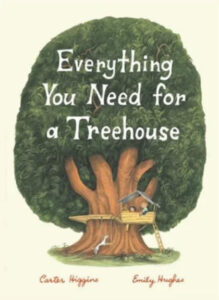 TN: When you first open to acquisitions, you read a lot of books, hundreds, that are publishable. You keep thinking, Is this the one? Is this good enough? If I pass on this, am I wrong? But then you read something that echoes across your whole life and inside your whole self, and you realize: This is the kind of book I want to edit. That’s how I felt when I read Carter Higgins’ Everything You Need for a Treehouse.
TN: When you first open to acquisitions, you read a lot of books, hundreds, that are publishable. You keep thinking, Is this the one? Is this good enough? If I pass on this, am I wrong? But then you read something that echoes across your whole life and inside your whole self, and you realize: This is the kind of book I want to edit. That’s how I felt when I read Carter Higgins’ Everything You Need for a Treehouse.
RVC: What’s the most important thing that experience taught you?
TN: That book was the first of so many I’d do with Carter, and that relationship—both professional and personal—is one of the major joys of my life. What I knew from the second I read that manuscript was that the person who wrote it had not just a book I wanted to publish, but a mind I wanted to publish. I wanted every thought she had to be synthesized into picture book form. (We are doing a pretty good job on this so far!)
And that’s really what I’m looking for when I’m reading submissions—the book, of course, needs to be precisely aligned with my ability to make it its best self, but I am more importantly reading for the person making it, hoping to find another person who will bring countless singular stories into kids’ hands and minds. When I acquire a book, I’m really hoping to “acquire” the relationship—my hope is always that it extends far further into the future than just a single book’s lifetime.
RVC: That’s a lovely way to put it–so many writers feel like this is such a mercenary industry, but it’s really about relationships.
TN: Absolutely.
RVC: You’ve said, “A good picture book should be able to be read by anybody.” What does that mean to you?
TN: Huh. I don’t know that I agree with the past self that said that. “Able to be read” to be read as in “available and allowed access to”? Yes, of course. But I feel strongly that no one should ever set out to write a book that will be loved by everybody. That’s how we get mediocre, similar, unchallenging books. A good book is a book that lots of kids will love, but for one kid, it will be the only book they love, or the first book they love—the book that makes them realize they’re not alone. The way to make such a book is not to set out to write something that will please broadly.
RVC: Tell me about a picture book or two that were particularly challenging to edit, and what made them so?
TN: Ah those are trade secrets, my friend.
RVC: Hah, okay. I have to ask, right? Now, how important is pacing in a picture book?
TN: Exceptionally.
RVC: What are some of your best examples of great pacing?
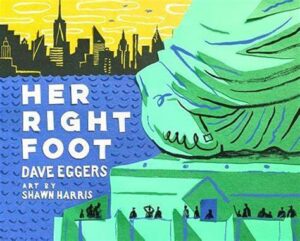 TN: Shawn Harris’ illustration work in Dave Eggers’ Her Right Foot is some of the best pacing I’ve ever seen in a picture book, and dealing with an unusual structure: The book is 112 pages, but the text isn’t all that long, only around 1500 words. Shawn’s innovation was to spool that text out carefully, so that each page has only a sentence or two on it. The effect is twofold—a parent doesn’t have to spend five minutes reading one single spread of text while their listener gets bored and starts to play with a toy (a problem with books consisting of gigantic blocks of text on every spread), and the reader has a sense of suspense. The sentences on each page start to build, and you start to wonder what’s coming. My metaphors are all cliché—the rolling of a snowball, the rumbling of an earthquake, the boiling in a pot—but what Shawn effects by placing the sentences as intentionally as he does is nothing short of an explosion of meaning and emotion when we reach the climax of the book. Shawn’s work in his visual pacing matches perfectly the narrative pacing in Dave’s text.
TN: Shawn Harris’ illustration work in Dave Eggers’ Her Right Foot is some of the best pacing I’ve ever seen in a picture book, and dealing with an unusual structure: The book is 112 pages, but the text isn’t all that long, only around 1500 words. Shawn’s innovation was to spool that text out carefully, so that each page has only a sentence or two on it. The effect is twofold—a parent doesn’t have to spend five minutes reading one single spread of text while their listener gets bored and starts to play with a toy (a problem with books consisting of gigantic blocks of text on every spread), and the reader has a sense of suspense. The sentences on each page start to build, and you start to wonder what’s coming. My metaphors are all cliché—the rolling of a snowball, the rumbling of an earthquake, the boiling in a pot—but what Shawn effects by placing the sentences as intentionally as he does is nothing short of an explosion of meaning and emotion when we reach the climax of the book. Shawn’s work in his visual pacing matches perfectly the narrative pacing in Dave’s text.
RVC: Since you brought up Dave Eggers, let me ask something writers wonder about. How is it different working with bigger-name writers than debut authors?
TN: The editor’s job is always to make each book its best self. That job doesn’t change no matter who you’re working with. The only difference in the task is that every book has a different best self, even books by the same author, so it’s your job to figure out what that unique best self is, and then work to shape the book according to that ideal self.
RVC: What sets Neal Porter Books apart in the competitive landscape of picture book publishing?
TN: Neal Porter Books places utmost emphasis on the highest quality and importance. Each of those adjectives apply both visually and narratively to the books that Neal has always published. These are books that look like nothing else and sound like nothing else, books that take those risks to greatness. I think the key is that, while we are a business and do have to hope that our books make money, we are looking for true works of art above all else: books that weren’t created with the intention to sell, or with the intention of making their author famous, but were simply created from a place of honesty and storytelling and an understanding of children and childhood. They are books that don’t condescend to children, but recognize that kids have just as vast, rich, complicated inner lives as adults do. They are books by people who value the authentic experience of children and are working to meet those children where they actually are.
RVC: Well said. Thanks for that. Let’s clarify something else that writers often don’t understand. You’re Executive Editor these days. How’s that different than Editor?
TN: The main difference is in the ability to self-direct. The team I work with now is much smaller, so we can be much nimbler and make decisions quickly. We have a lot of fun, I have to say! As an editor at Chronicle Books, I was a smaller part of a larger machine, so things took longer and required more elaborate obstacle courses.
RVC: What is the most difficult aspect of your work?
TN: I wouldn’t characterize this as difficult, because I love it, but I would say that it’s not a job for someone who wants a clean break between work and home life. There are very few minutes in a day when I’m not actively doing my job. It’s my whole life. I feel really lucky about that. But I realize most people probably want a bit more personal time. :]
RVC: What’s the most common misconception about being an editor?
TN: That it is easy, and that kids’ books are cute. Also, most people don’t realize that—most people you meet think they want to write or have written a picture book. It’s a very sweet impulse and I’m glad humans are a people with such a pure storytelling instinct, but most of the books I hear about don’t necessarily warrant publication, which can be kind of a conversation killer. :] So I try to avoid telling people what my job is in taxis or at cocktail parties.
RVC: What keeps you motivated to continue being a kidlit editor?
TN: The job itself. The people devoting their lives to this. Art. The way original stories never stop being told. There’s no end to the motivation.
RVC: Here’s one of those commonly asked questions that people still love to ask. How can new authors or illustrators get their work noticed in this competitive field?
TN: Get an agent; say yes to everything; be easy to find online and legible once found; go to events that you don’t feel like going to and talk to more people than you think you should have to. Again, the personal relationships in this business are everything. They are what will get you in it and what will get you through it. Take care of those better than you do your house keys.
RVC: Last question for this part of the interview. What’s the most treasured picture book in your collection, and why?
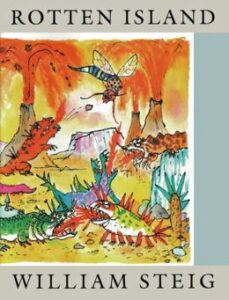 TN: Rotten Island, by William Steig. I could talk to you for hours about how important Steig is, how much he understood the value of character and how his decision always to lead with story and character rather than concept or “moral” is why the books stand the test of time (and, in many cases, actually convey something meaningful far better than the books who start out with that explicit purpose).
TN: Rotten Island, by William Steig. I could talk to you for hours about how important Steig is, how much he understood the value of character and how his decision always to lead with story and character rather than concept or “moral” is why the books stand the test of time (and, in many cases, actually convey something meaningful far better than the books who start out with that explicit purpose).
RVC: Totally agree!
TN: The reason Rotten Island is an extremely important book to me is because of how much I loved this book as a kid, and how much I was not the intended audience of this book. Rotten Island is about this island where everything that happens is rotten and everyone on it is rotten, to the extent that even when a flower blooms, they fight over the flower because it’s the first beautiful thing anyone has ever seen. I was a typical good kid, loved my teachers and hated being in trouble, hated people being mad at me, identified as Mary Ann from the BSC because she cried all the time and Baby Spice because my mom was my best friend. But I loved this book. It’s a major reminder to me that we (as both kids and adults) turn to books for all kinds of reasons. Yes, we turn to books to feel seen and to see our realities reflected. But we also turn to books to exorcise the pieces of ourselves that we dislike, to experiment with ways that we don’t feel comfortable being in real life, to go live somewhere as our own categorical opposite and see how it feels. Fiction can be and should be somewhere you can go be someone else for a little while. What a relief that there is such a place! Take me to Rotten Island any day.
RVC: Alright, Taylor. It’s time to up the ante and raise the stakes—it’s the LIGHTNING ROUND! We’re looking for zappy questions followed by zoomy answers. Are you ready?
TN: Yep!
RVC: What makes you roll your eyes every time you see/hear/read it?
TN: “SEL.” Every piece of fiction should be a social emotional learning experience. That’s what reading is! To name it as such feels like a real estate agent trying to convince you that “SoMa” is a different and far more romantic place than “South of Market.”
RVC: Most surprising song on your playlist?
TN: My most listened to albums, by a good margin, are A Tribe Called Quest’s The Low End Theory (my choice) and the Snow White Original Soundtrack (my young son’s current obsession).
RVC: Most underappreciated Girl Scout cookie?
TN: Well, you know you’ve become an adult when you suddenly start evangelizing for Peanut Butter Sandwiches over Peanut Butter Patties, and I’m nothing special in that regard.
RVC: If you could trade lives with any picture book character for a day, who would it be and what would you do?
TN: I’d be a dog in Go, Dog. Go! Not one of the hat conversationalists. Just one of the regular dogs. I’d go to that dog party in the tree!
RVC: What’s a recent picture book that deserves a lot of notice than it’s gotten so far?
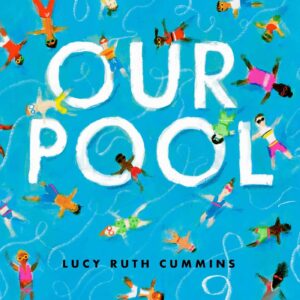 TN: Our Pool, by Lucy Ruth Cummins, and There Was a Party for Langston: King O’ Letters, written by Jason Reynolds, illustrated by Jarrett and Jerome Pumphrey. These are two of my favorite books this year. Lucy’s is the kind of book that reminds you how important a fun book is—a book that feels exactly like the joy and exhilaration of going to the pool on a hot no-school day. It’s incredibly inclusive, even down to the fact that the speaker of the book is never identified, so as you read you can kind of “choose” which character you want to pretend to be, depending on which of the many lifestyles you see. It’s a sensational book, literally: Reading it you can sense the squelch in your flipflops, smell the chlorine and the humid changing room, feel the sun burning your eyes. It’s as bright as a sunglasses-free afternoon and as happy as the ice cream truck coming around the corner. So good.
TN: Our Pool, by Lucy Ruth Cummins, and There Was a Party for Langston: King O’ Letters, written by Jason Reynolds, illustrated by Jarrett and Jerome Pumphrey. These are two of my favorite books this year. Lucy’s is the kind of book that reminds you how important a fun book is—a book that feels exactly like the joy and exhilaration of going to the pool on a hot no-school day. It’s incredibly inclusive, even down to the fact that the speaker of the book is never identified, so as you read you can kind of “choose” which character you want to pretend to be, depending on which of the many lifestyles you see. It’s a sensational book, literally: Reading it you can sense the squelch in your flipflops, smell the chlorine and the humid changing room, feel the sun burning your eyes. It’s as bright as a sunglasses-free afternoon and as happy as the ice cream truck coming around the corner. So good.
And Langston pulls off the hardest feat ever—making relevant an artist who most young readers won’t have encountered yet. I can guarantee that this book will be the reason many kids go read their first Langston Hughes poem. The book truly does feel, look, and sound like a party. Jason’s text is beyond engaging, doesn’t just ask the reader to dance but actually makes them want to and actually makes them feel like they’re pulling off all the best moves. And the Pumphreys’ artwork, and general visual concept, is stunning—a whole new world for them, ambitious and ridiculously successful. Everyone brought their A‑game to this book.
RVC: [Note the OPB piece on the Langston book right here!] Complete the sentence in five words or fewer: “Taylor Norman is an editor who…”
TN: believes readers need all books.
RVC: Thanks so much, Taylor!


Great interview!
Great interview! So nice to learn more about the editing process and why Taylor is so good at her job. I also loved hearing about Taylor’s favorite projects. Can’t wait to read them.
Great interview!
I loved this. Thank you, Taylor and Ryan.
Terrific interview! So interesting to read about another editor who was sure she wanted to be an editor as a 13-year-old. Maybe there are several others, too! 🙂
Great interview! Love the advice to care for relationships better than your house keys.
Thank you for the superb interview! What insights!
Love this interview! Thank you!